MOD003325 - Analyzing Car-Free City Impacts: An Academic Report
VerifiedAdded on 2023/06/17
|10
|2828
|185
Report
AI Summary
This report provides an analysis of the economic, environmental, and social impacts of implementing car-free zones in urban areas. It discusses the potential benefits such as reduced carbon emissions, improved air quality, and enhanced public health, as well as challenges related to public behavior, transportation infrastructure, and economic activities. The report explores the effects on employment, business operations, and revenue, while also considering the influence on societal structures, crime rates, and buying habits. It concludes with recommendations for maximizing the benefits and minimizing the challenges associated with car-free city initiatives, such as investing in public transportation and promoting the use of electric vehicles.

Academic and Professional
Skills
Skills
Paraphrase This Document
Need a fresh take? Get an instant paraphrase of this document with our AI Paraphraser
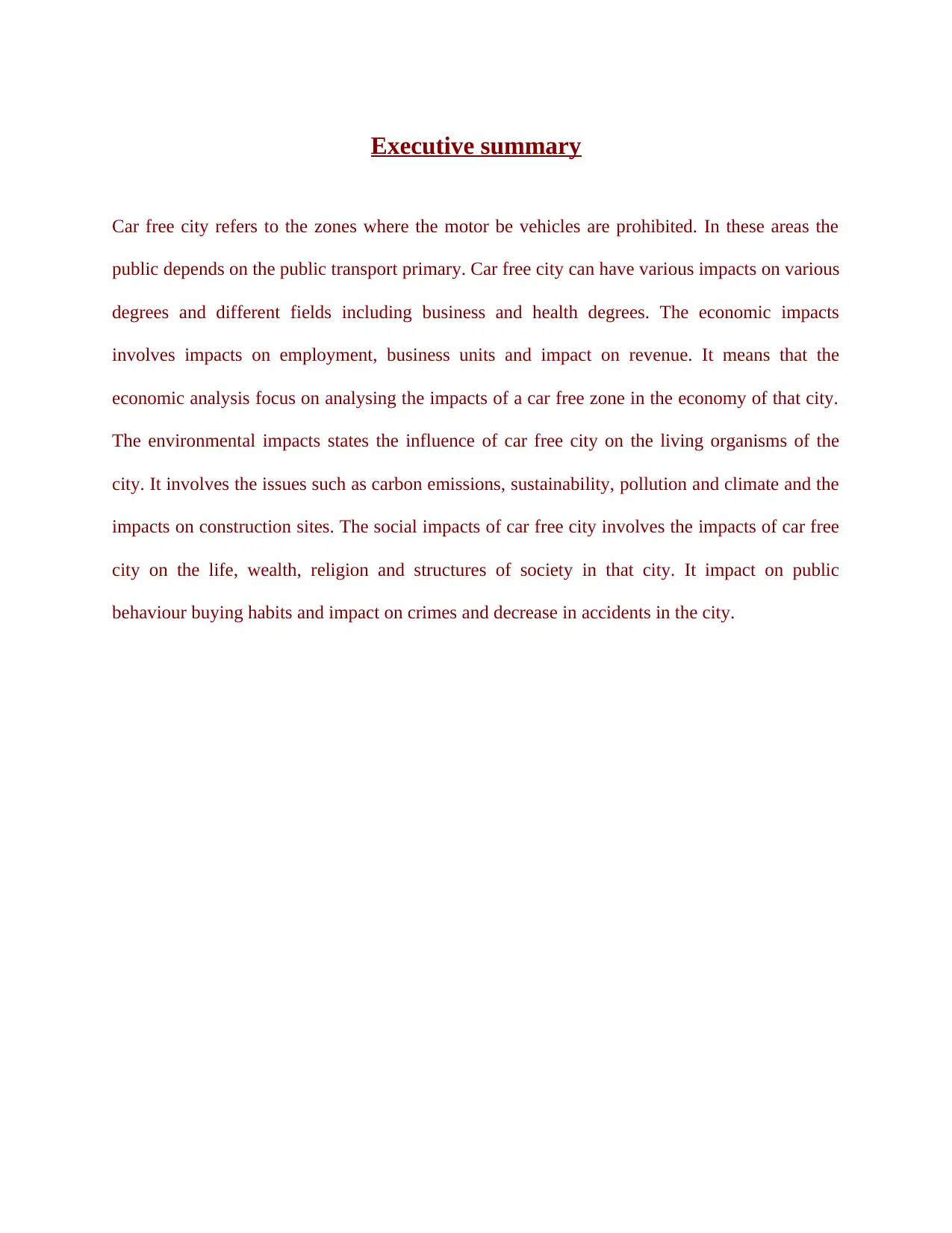
Executive summary
Car free city refers to the zones where the motor be vehicles are prohibited. In these areas the
public depends on the public transport primary. Car free city can have various impacts on various
degrees and different fields including business and health degrees. The economic impacts
involves impacts on employment, business units and impact on revenue. It means that the
economic analysis focus on analysing the impacts of a car free zone in the economy of that city.
The environmental impacts states the influence of car free city on the living organisms of the
city. It involves the issues such as carbon emissions, sustainability, pollution and climate and the
impacts on construction sites. The social impacts of car free city involves the impacts of car free
city on the life, wealth, religion and structures of society in that city. It impact on public
behaviour buying habits and impact on crimes and decrease in accidents in the city.
Car free city refers to the zones where the motor be vehicles are prohibited. In these areas the
public depends on the public transport primary. Car free city can have various impacts on various
degrees and different fields including business and health degrees. The economic impacts
involves impacts on employment, business units and impact on revenue. It means that the
economic analysis focus on analysing the impacts of a car free zone in the economy of that city.
The environmental impacts states the influence of car free city on the living organisms of the
city. It involves the issues such as carbon emissions, sustainability, pollution and climate and the
impacts on construction sites. The social impacts of car free city involves the impacts of car free
city on the life, wealth, religion and structures of society in that city. It impact on public
behaviour buying habits and impact on crimes and decrease in accidents in the city.

Table of Contents
INTRODUCTION...........................................................................................................................3
MAIN BODY...................................................................................................................................3
Analysis of The Economic impacts.............................................................................................3
Analysis of The Environmental Impacts......................................................................................4
Analysis of the Social Impact .....................................................................................................5
CONCLUSION................................................................................................................................6
RECOMMENDATIONS.................................................................................................................6
REFERENCES................................................................................................................................1
INTRODUCTION...........................................................................................................................3
MAIN BODY...................................................................................................................................3
Analysis of The Economic impacts.............................................................................................3
Analysis of The Environmental Impacts......................................................................................4
Analysis of the Social Impact .....................................................................................................5
CONCLUSION................................................................................................................................6
RECOMMENDATIONS.................................................................................................................6
REFERENCES................................................................................................................................1
⊘ This is a preview!⊘
Do you want full access?
Subscribe today to unlock all pages.

Trusted by 1+ million students worldwide
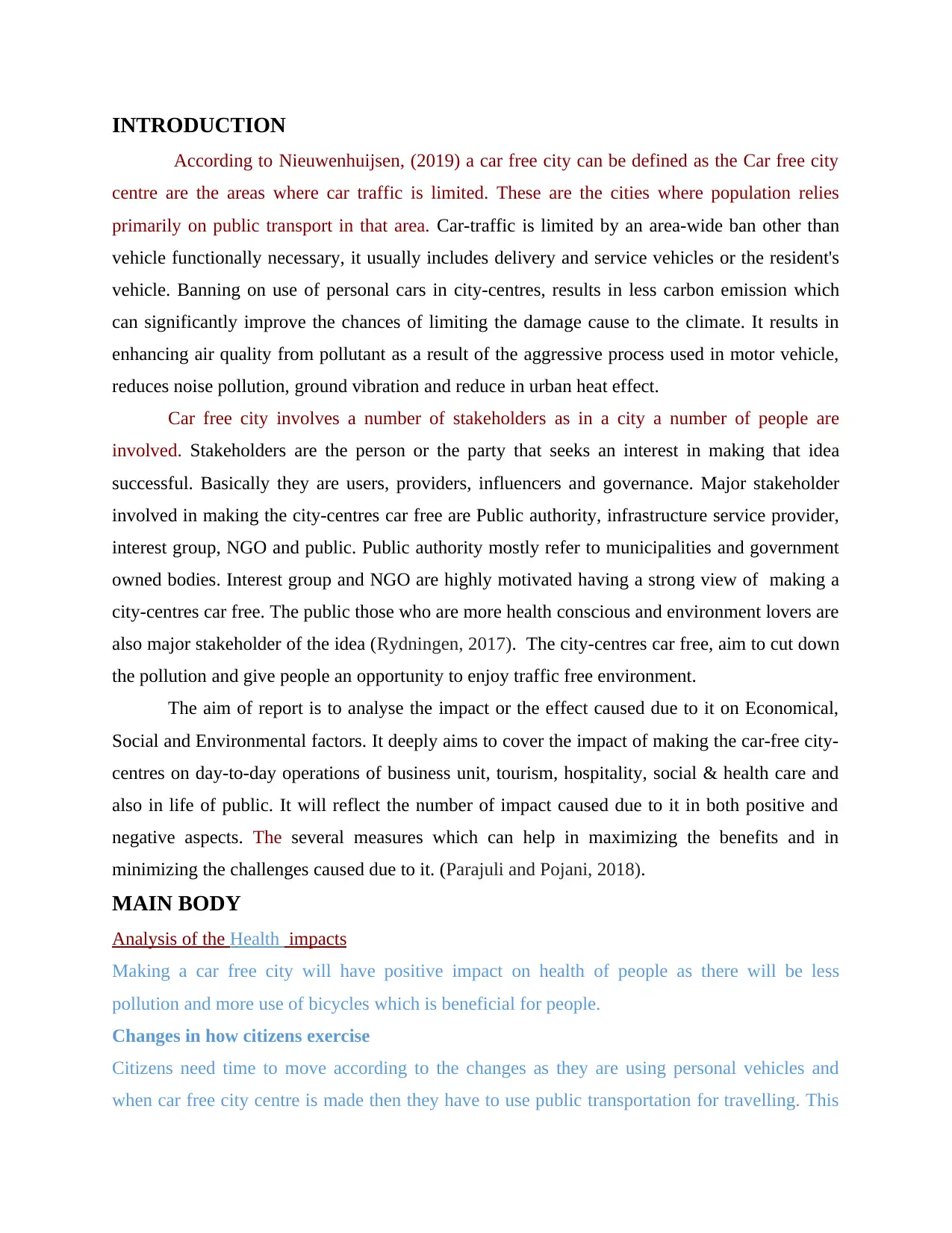
INTRODUCTION
According to Nieuwenhuijsen, (2019) a car free city can be defined as the Car free city
centre are the areas where car traffic is limited. These are the cities where population relies
primarily on public transport in that area. Car-traffic is limited by an area-wide ban other than
vehicle functionally necessary, it usually includes delivery and service vehicles or the resident's
vehicle. Banning on use of personal cars in city-centres, results in less carbon emission which
can significantly improve the chances of limiting the damage cause to the climate. It results in
enhancing air quality from pollutant as a result of the aggressive process used in motor vehicle,
reduces noise pollution, ground vibration and reduce in urban heat effect.
Car free city involves a number of stakeholders as in a city a number of people are
involved. Stakeholders are the person or the party that seeks an interest in making that idea
successful. Basically they are users, providers, influencers and governance. Major stakeholder
involved in making the city-centres car free are Public authority, infrastructure service provider,
interest group, NGO and public. Public authority mostly refer to municipalities and government
owned bodies. Interest group and NGO are highly motivated having a strong view of making a
city-centres car free. The public those who are more health conscious and environment lovers are
also major stakeholder of the idea (Rydningen, 2017). The city-centres car free, aim to cut down
the pollution and give people an opportunity to enjoy traffic free environment.
The aim of report is to analyse the impact or the effect caused due to it on Economical,
Social and Environmental factors. It deeply aims to cover the impact of making the car-free city-
centres on day-to-day operations of business unit, tourism, hospitality, social & health care and
also in life of public. It will reflect the number of impact caused due to it in both positive and
negative aspects. The several measures which can help in maximizing the benefits and in
minimizing the challenges caused due to it. (Parajuli and Pojani, 2018).
MAIN BODY
Analysis of the Health impacts
Making a car free city will have positive impact on health of people as there will be less
pollution and more use of bicycles which is beneficial for people.
Changes in how citizens exercise
Citizens need time to move according to the changes as they are using personal vehicles and
when car free city centre is made then they have to use public transportation for travelling. This
According to Nieuwenhuijsen, (2019) a car free city can be defined as the Car free city
centre are the areas where car traffic is limited. These are the cities where population relies
primarily on public transport in that area. Car-traffic is limited by an area-wide ban other than
vehicle functionally necessary, it usually includes delivery and service vehicles or the resident's
vehicle. Banning on use of personal cars in city-centres, results in less carbon emission which
can significantly improve the chances of limiting the damage cause to the climate. It results in
enhancing air quality from pollutant as a result of the aggressive process used in motor vehicle,
reduces noise pollution, ground vibration and reduce in urban heat effect.
Car free city involves a number of stakeholders as in a city a number of people are
involved. Stakeholders are the person or the party that seeks an interest in making that idea
successful. Basically they are users, providers, influencers and governance. Major stakeholder
involved in making the city-centres car free are Public authority, infrastructure service provider,
interest group, NGO and public. Public authority mostly refer to municipalities and government
owned bodies. Interest group and NGO are highly motivated having a strong view of making a
city-centres car free. The public those who are more health conscious and environment lovers are
also major stakeholder of the idea (Rydningen, 2017). The city-centres car free, aim to cut down
the pollution and give people an opportunity to enjoy traffic free environment.
The aim of report is to analyse the impact or the effect caused due to it on Economical,
Social and Environmental factors. It deeply aims to cover the impact of making the car-free city-
centres on day-to-day operations of business unit, tourism, hospitality, social & health care and
also in life of public. It will reflect the number of impact caused due to it in both positive and
negative aspects. The several measures which can help in maximizing the benefits and in
minimizing the challenges caused due to it. (Parajuli and Pojani, 2018).
MAIN BODY
Analysis of the Health impacts
Making a car free city will have positive impact on health of people as there will be less
pollution and more use of bicycles which is beneficial for people.
Changes in how citizens exercise
Citizens need time to move according to the changes as they are using personal vehicles and
when car free city centre is made then they have to use public transportation for travelling. This
Paraphrase This Document
Need a fresh take? Get an instant paraphrase of this document with our AI Paraphraser
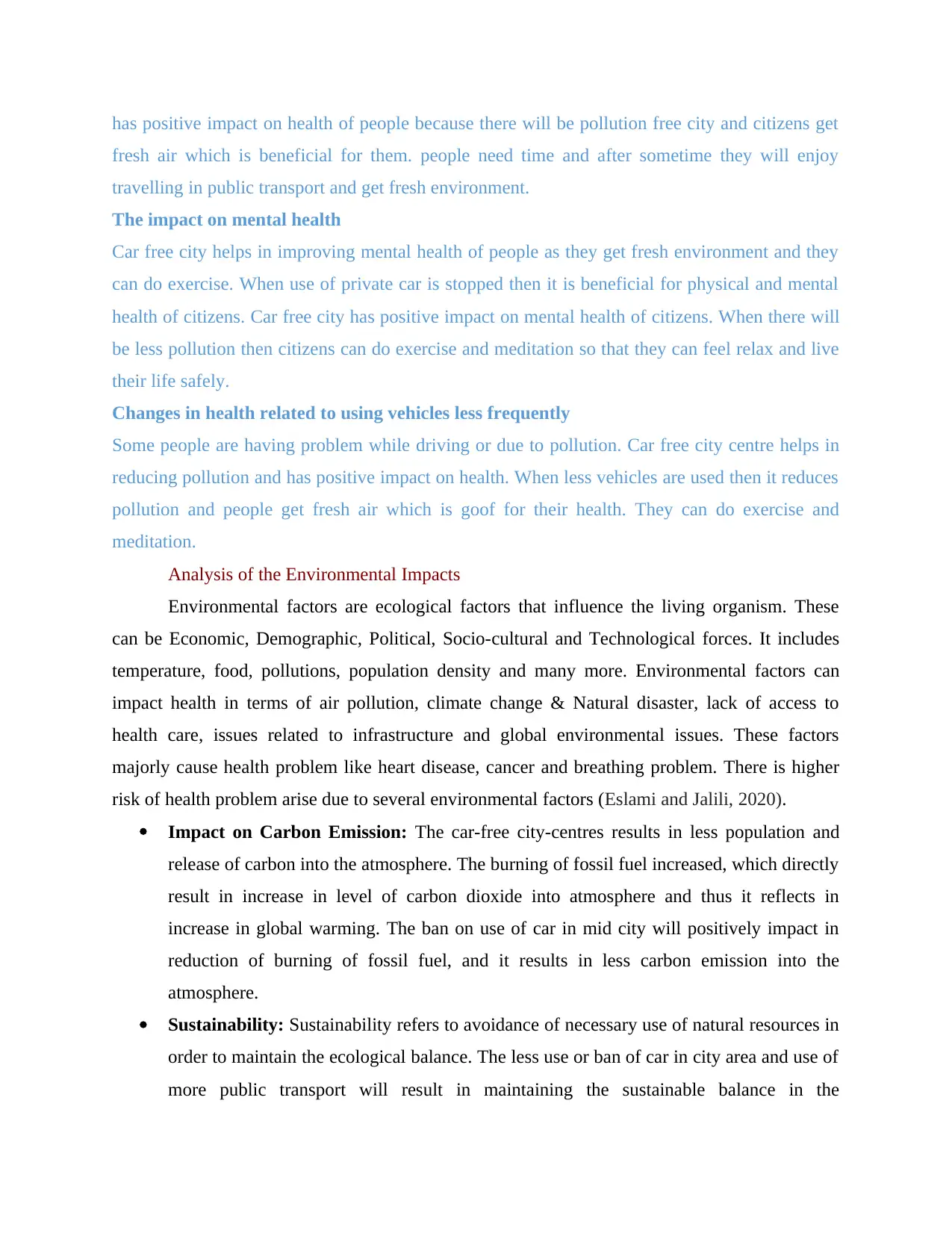
has positive impact on health of people because there will be pollution free city and citizens get
fresh air which is beneficial for them. people need time and after sometime they will enjoy
travelling in public transport and get fresh environment.
The impact on mental health
Car free city helps in improving mental health of people as they get fresh environment and they
can do exercise. When use of private car is stopped then it is beneficial for physical and mental
health of citizens. Car free city has positive impact on mental health of citizens. When there will
be less pollution then citizens can do exercise and meditation so that they can feel relax and live
their life safely.
Changes in health related to using vehicles less frequently
Some people are having problem while driving or due to pollution. Car free city centre helps in
reducing pollution and has positive impact on health. When less vehicles are used then it reduces
pollution and people get fresh air which is goof for their health. They can do exercise and
meditation.
Analysis of the Environmental Impacts
Environmental factors are ecological factors that influence the living organism. These
can be Economic, Demographic, Political, Socio-cultural and Technological forces. It includes
temperature, food, pollutions, population density and many more. Environmental factors can
impact health in terms of air pollution, climate change & Natural disaster, lack of access to
health care, issues related to infrastructure and global environmental issues. These factors
majorly cause health problem like heart disease, cancer and breathing problem. There is higher
risk of health problem arise due to several environmental factors (Eslami and Jalili, 2020).
Impact on Carbon Emission: The car-free city-centres results in less population and
release of carbon into the atmosphere. The burning of fossil fuel increased, which directly
result in increase in level of carbon dioxide into atmosphere and thus it reflects in
increase in global warming. The ban on use of car in mid city will positively impact in
reduction of burning of fossil fuel, and it results in less carbon emission into the
atmosphere.
Sustainability: Sustainability refers to avoidance of necessary use of natural resources in
order to maintain the ecological balance. The less use or ban of car in city area and use of
more public transport will result in maintaining the sustainable balance in the
fresh air which is beneficial for them. people need time and after sometime they will enjoy
travelling in public transport and get fresh environment.
The impact on mental health
Car free city helps in improving mental health of people as they get fresh environment and they
can do exercise. When use of private car is stopped then it is beneficial for physical and mental
health of citizens. Car free city has positive impact on mental health of citizens. When there will
be less pollution then citizens can do exercise and meditation so that they can feel relax and live
their life safely.
Changes in health related to using vehicles less frequently
Some people are having problem while driving or due to pollution. Car free city centre helps in
reducing pollution and has positive impact on health. When less vehicles are used then it reduces
pollution and people get fresh air which is goof for their health. They can do exercise and
meditation.
Analysis of the Environmental Impacts
Environmental factors are ecological factors that influence the living organism. These
can be Economic, Demographic, Political, Socio-cultural and Technological forces. It includes
temperature, food, pollutions, population density and many more. Environmental factors can
impact health in terms of air pollution, climate change & Natural disaster, lack of access to
health care, issues related to infrastructure and global environmental issues. These factors
majorly cause health problem like heart disease, cancer and breathing problem. There is higher
risk of health problem arise due to several environmental factors (Eslami and Jalili, 2020).
Impact on Carbon Emission: The car-free city-centres results in less population and
release of carbon into the atmosphere. The burning of fossil fuel increased, which directly
result in increase in level of carbon dioxide into atmosphere and thus it reflects in
increase in global warming. The ban on use of car in mid city will positively impact in
reduction of burning of fossil fuel, and it results in less carbon emission into the
atmosphere.
Sustainability: Sustainability refers to avoidance of necessary use of natural resources in
order to maintain the ecological balance. The less use or ban of car in city area and use of
more public transport will result in maintaining the sustainable balance in the
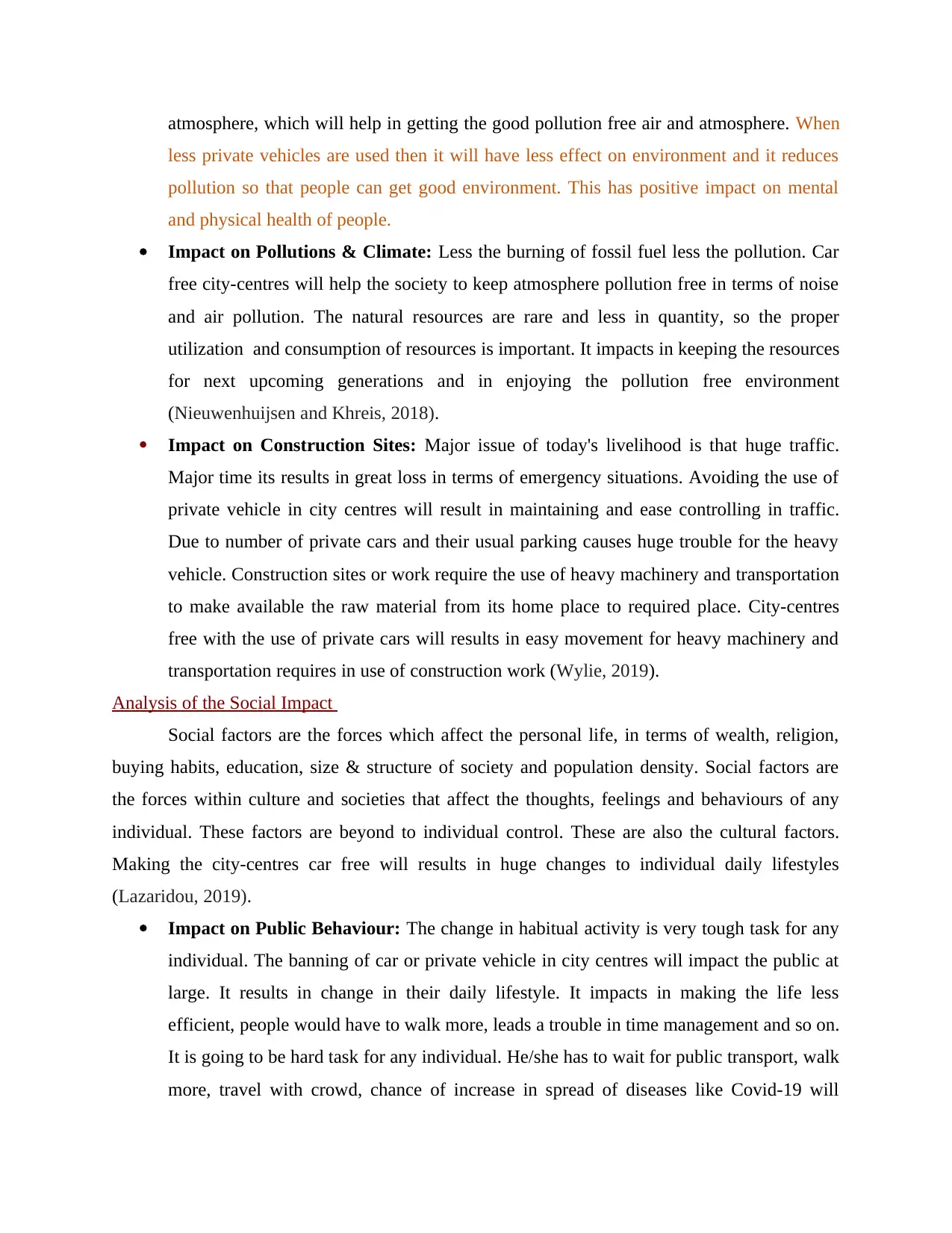
atmosphere, which will help in getting the good pollution free air and atmosphere. When
less private vehicles are used then it will have less effect on environment and it reduces
pollution so that people can get good environment. This has positive impact on mental
and physical health of people.
Impact on Pollutions & Climate: Less the burning of fossil fuel less the pollution. Car
free city-centres will help the society to keep atmosphere pollution free in terms of noise
and air pollution. The natural resources are rare and less in quantity, so the proper
utilization and consumption of resources is important. It impacts in keeping the resources
for next upcoming generations and in enjoying the pollution free environment
(Nieuwenhuijsen and Khreis, 2018).
Impact on Construction Sites: Major issue of today's livelihood is that huge traffic.
Major time its results in great loss in terms of emergency situations. Avoiding the use of
private vehicle in city centres will result in maintaining and ease controlling in traffic.
Due to number of private cars and their usual parking causes huge trouble for the heavy
vehicle. Construction sites or work require the use of heavy machinery and transportation
to make available the raw material from its home place to required place. City-centres
free with the use of private cars will results in easy movement for heavy machinery and
transportation requires in use of construction work (Wylie, 2019).
Analysis of the Social Impact
Social factors are the forces which affect the personal life, in terms of wealth, religion,
buying habits, education, size & structure of society and population density. Social factors are
the forces within culture and societies that affect the thoughts, feelings and behaviours of any
individual. These factors are beyond to individual control. These are also the cultural factors.
Making the city-centres car free will results in huge changes to individual daily lifestyles
(Lazaridou, 2019).
Impact on Public Behaviour: The change in habitual activity is very tough task for any
individual. The banning of car or private vehicle in city centres will impact the public at
large. It results in change in their daily lifestyle. It impacts in making the life less
efficient, people would have to walk more, leads a trouble in time management and so on.
It is going to be hard task for any individual. He/she has to wait for public transport, walk
more, travel with crowd, chance of increase in spread of diseases like Covid-19 will
less private vehicles are used then it will have less effect on environment and it reduces
pollution so that people can get good environment. This has positive impact on mental
and physical health of people.
Impact on Pollutions & Climate: Less the burning of fossil fuel less the pollution. Car
free city-centres will help the society to keep atmosphere pollution free in terms of noise
and air pollution. The natural resources are rare and less in quantity, so the proper
utilization and consumption of resources is important. It impacts in keeping the resources
for next upcoming generations and in enjoying the pollution free environment
(Nieuwenhuijsen and Khreis, 2018).
Impact on Construction Sites: Major issue of today's livelihood is that huge traffic.
Major time its results in great loss in terms of emergency situations. Avoiding the use of
private vehicle in city centres will result in maintaining and ease controlling in traffic.
Due to number of private cars and their usual parking causes huge trouble for the heavy
vehicle. Construction sites or work require the use of heavy machinery and transportation
to make available the raw material from its home place to required place. City-centres
free with the use of private cars will results in easy movement for heavy machinery and
transportation requires in use of construction work (Wylie, 2019).
Analysis of the Social Impact
Social factors are the forces which affect the personal life, in terms of wealth, religion,
buying habits, education, size & structure of society and population density. Social factors are
the forces within culture and societies that affect the thoughts, feelings and behaviours of any
individual. These factors are beyond to individual control. These are also the cultural factors.
Making the city-centres car free will results in huge changes to individual daily lifestyles
(Lazaridou, 2019).
Impact on Public Behaviour: The change in habitual activity is very tough task for any
individual. The banning of car or private vehicle in city centres will impact the public at
large. It results in change in their daily lifestyle. It impacts in making the life less
efficient, people would have to walk more, leads a trouble in time management and so on.
It is going to be hard task for any individual. He/she has to wait for public transport, walk
more, travel with crowd, chance of increase in spread of diseases like Covid-19 will
⊘ This is a preview!⊘
Do you want full access?
Subscribe today to unlock all pages.

Trusted by 1+ million students worldwide

increase. So the banning of car or private vehicle in city-centres will lead a huge impact
on public behaviour.
Impact on Crimes & decrease in Accident: Crime in today's era are increasing day-by-
day. Majorly crime are performed in private vehicle in most of the countries. The ban on
use of cars and private vehicle will impact in reduction of crime rate. The crime like drug
& alcohol consumption, violent crime, fraud and any other offence will decline. The
death rate of accident due to drink and drive will also decrease.
Change in Buying Habits: The car free city-centres will also result in change in the
buying habits of individual. Instead of preferring cars, public will switch themselves
towards the bicycles to make their life more efficient. They will go for electric cars which
does not cause much harm to the environment. Public easily does not change themselves,
but they will ready to adopt the substitute. Their buying preference will be changed to
bicycles in terms of cars, but they will adopt that practice only which give them easy
working and maintaining their lifestyle (Topp and Pharoah, 2018).
CONCLUSION
With the above analysis and discussion it has been concluded that there are several
benefits and the challenges which can be faced due to ban or use of cars in city-centres. It
evaluated the study in terms of Economic, Environmental and social impact. The restriction on
use of car in city centres has impacted the society in both positive and in negative manner. The
rapid use of natural resources one day will result in its exhaustion. Use of private cars in huge
amount, burns the large amount of fossil fuel and results in carbon emission which increase the
global warming and pollutes the surrounding environment. To maximize the benefits and to
minimize the challenges, number of measures has been taken which can serve the society in well
manner. Rather than restricting the use of cars in city-centres, the use of electric or battery cars
can be given more importance, as it will be easy for society to adopt it. Furthermore, it has been
identified that this will result in Change With No Change in Daily livelihood.
RECOMMENDATIONS
The use or ban of cars in city-centres or making the city-centres car free, is not an easy
task to implement. Any change which directly impact the daily livelihood of individual is hardly
adopted by the public which results in huge change in public behaviour and their daily
operations. For the successful implementation & follow-up, there are certain measure which will
on public behaviour.
Impact on Crimes & decrease in Accident: Crime in today's era are increasing day-by-
day. Majorly crime are performed in private vehicle in most of the countries. The ban on
use of cars and private vehicle will impact in reduction of crime rate. The crime like drug
& alcohol consumption, violent crime, fraud and any other offence will decline. The
death rate of accident due to drink and drive will also decrease.
Change in Buying Habits: The car free city-centres will also result in change in the
buying habits of individual. Instead of preferring cars, public will switch themselves
towards the bicycles to make their life more efficient. They will go for electric cars which
does not cause much harm to the environment. Public easily does not change themselves,
but they will ready to adopt the substitute. Their buying preference will be changed to
bicycles in terms of cars, but they will adopt that practice only which give them easy
working and maintaining their lifestyle (Topp and Pharoah, 2018).
CONCLUSION
With the above analysis and discussion it has been concluded that there are several
benefits and the challenges which can be faced due to ban or use of cars in city-centres. It
evaluated the study in terms of Economic, Environmental and social impact. The restriction on
use of car in city centres has impacted the society in both positive and in negative manner. The
rapid use of natural resources one day will result in its exhaustion. Use of private cars in huge
amount, burns the large amount of fossil fuel and results in carbon emission which increase the
global warming and pollutes the surrounding environment. To maximize the benefits and to
minimize the challenges, number of measures has been taken which can serve the society in well
manner. Rather than restricting the use of cars in city-centres, the use of electric or battery cars
can be given more importance, as it will be easy for society to adopt it. Furthermore, it has been
identified that this will result in Change With No Change in Daily livelihood.
RECOMMENDATIONS
The use or ban of cars in city-centres or making the city-centres car free, is not an easy
task to implement. Any change which directly impact the daily livelihood of individual is hardly
adopted by the public which results in huge change in public behaviour and their daily
operations. For the successful implementation & follow-up, there are certain measure which will
Paraphrase This Document
Need a fresh take? Get an instant paraphrase of this document with our AI Paraphraser
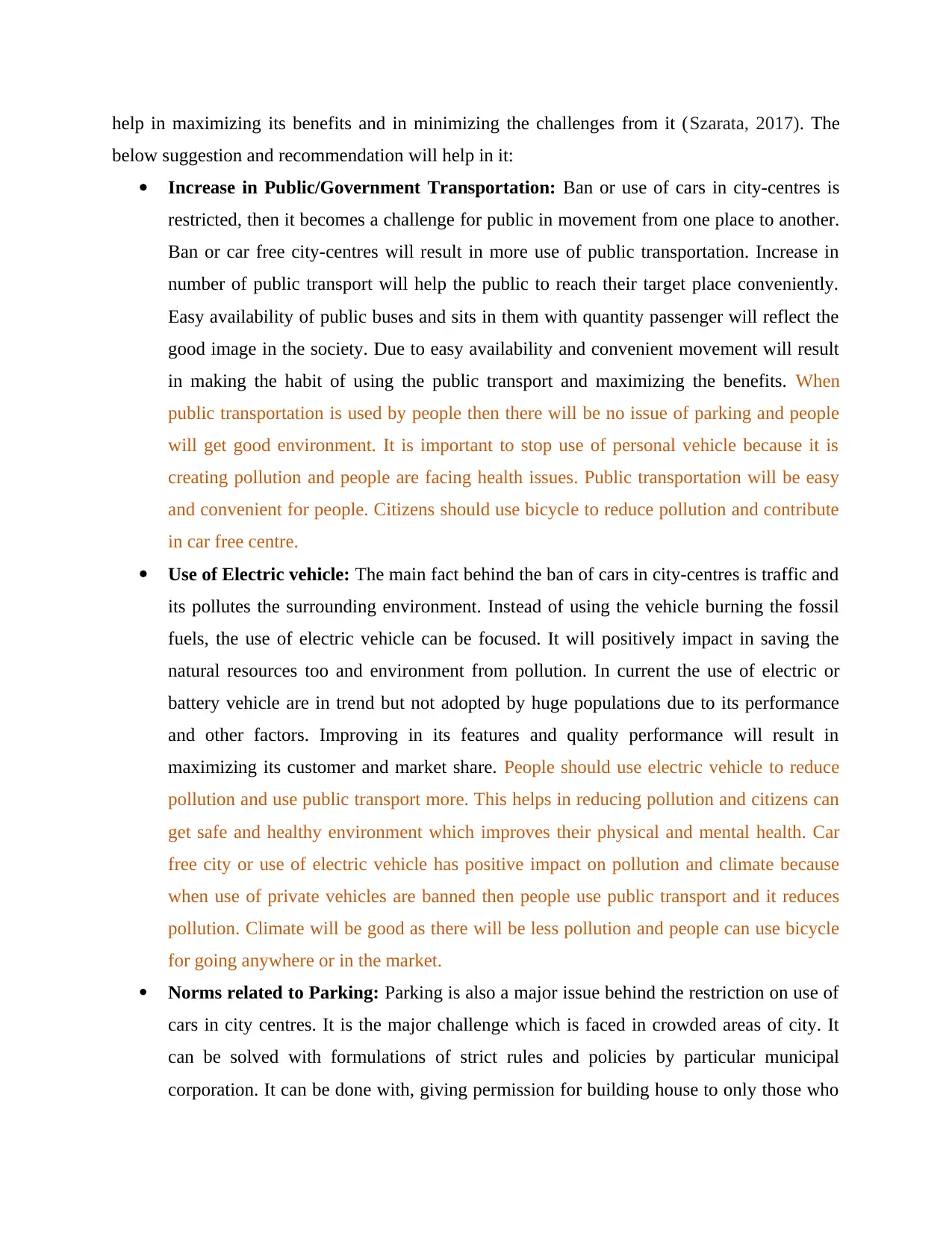
help in maximizing its benefits and in minimizing the challenges from it (Szarata, 2017). The
below suggestion and recommendation will help in it:
Increase in Public/Government Transportation: Ban or use of cars in city-centres is
restricted, then it becomes a challenge for public in movement from one place to another.
Ban or car free city-centres will result in more use of public transportation. Increase in
number of public transport will help the public to reach their target place conveniently.
Easy availability of public buses and sits in them with quantity passenger will reflect the
good image in the society. Due to easy availability and convenient movement will result
in making the habit of using the public transport and maximizing the benefits. When
public transportation is used by people then there will be no issue of parking and people
will get good environment. It is important to stop use of personal vehicle because it is
creating pollution and people are facing health issues. Public transportation will be easy
and convenient for people. Citizens should use bicycle to reduce pollution and contribute
in car free centre.
Use of Electric vehicle: The main fact behind the ban of cars in city-centres is traffic and
its pollutes the surrounding environment. Instead of using the vehicle burning the fossil
fuels, the use of electric vehicle can be focused. It will positively impact in saving the
natural resources too and environment from pollution. In current the use of electric or
battery vehicle are in trend but not adopted by huge populations due to its performance
and other factors. Improving in its features and quality performance will result in
maximizing its customer and market share. People should use electric vehicle to reduce
pollution and use public transport more. This helps in reducing pollution and citizens can
get safe and healthy environment which improves their physical and mental health. Car
free city or use of electric vehicle has positive impact on pollution and climate because
when use of private vehicles are banned then people use public transport and it reduces
pollution. Climate will be good as there will be less pollution and people can use bicycle
for going anywhere or in the market.
Norms related to Parking: Parking is also a major issue behind the restriction on use of
cars in city centres. It is the major challenge which is faced in crowded areas of city. It
can be solved with formulations of strict rules and policies by particular municipal
corporation. It can be done with, giving permission for building house to only those who
below suggestion and recommendation will help in it:
Increase in Public/Government Transportation: Ban or use of cars in city-centres is
restricted, then it becomes a challenge for public in movement from one place to another.
Ban or car free city-centres will result in more use of public transportation. Increase in
number of public transport will help the public to reach their target place conveniently.
Easy availability of public buses and sits in them with quantity passenger will reflect the
good image in the society. Due to easy availability and convenient movement will result
in making the habit of using the public transport and maximizing the benefits. When
public transportation is used by people then there will be no issue of parking and people
will get good environment. It is important to stop use of personal vehicle because it is
creating pollution and people are facing health issues. Public transportation will be easy
and convenient for people. Citizens should use bicycle to reduce pollution and contribute
in car free centre.
Use of Electric vehicle: The main fact behind the ban of cars in city-centres is traffic and
its pollutes the surrounding environment. Instead of using the vehicle burning the fossil
fuels, the use of electric vehicle can be focused. It will positively impact in saving the
natural resources too and environment from pollution. In current the use of electric or
battery vehicle are in trend but not adopted by huge populations due to its performance
and other factors. Improving in its features and quality performance will result in
maximizing its customer and market share. People should use electric vehicle to reduce
pollution and use public transport more. This helps in reducing pollution and citizens can
get safe and healthy environment which improves their physical and mental health. Car
free city or use of electric vehicle has positive impact on pollution and climate because
when use of private vehicles are banned then people use public transport and it reduces
pollution. Climate will be good as there will be less pollution and people can use bicycle
for going anywhere or in the market.
Norms related to Parking: Parking is also a major issue behind the restriction on use of
cars in city centres. It is the major challenge which is faced in crowded areas of city. It
can be solved with formulations of strict rules and policies by particular municipal
corporation. It can be done with, giving permission for building house to only those who

have construction plan with parking structure, registering only those vehicles whose
owner has parking facility and several more. These measure can help in controlling the
traffic jam arise due to usual parking of cars at market place.
owner has parking facility and several more. These measure can help in controlling the
traffic jam arise due to usual parking of cars at market place.
⊘ This is a preview!⊘
Do you want full access?
Subscribe today to unlock all pages.

Trusted by 1+ million students worldwide
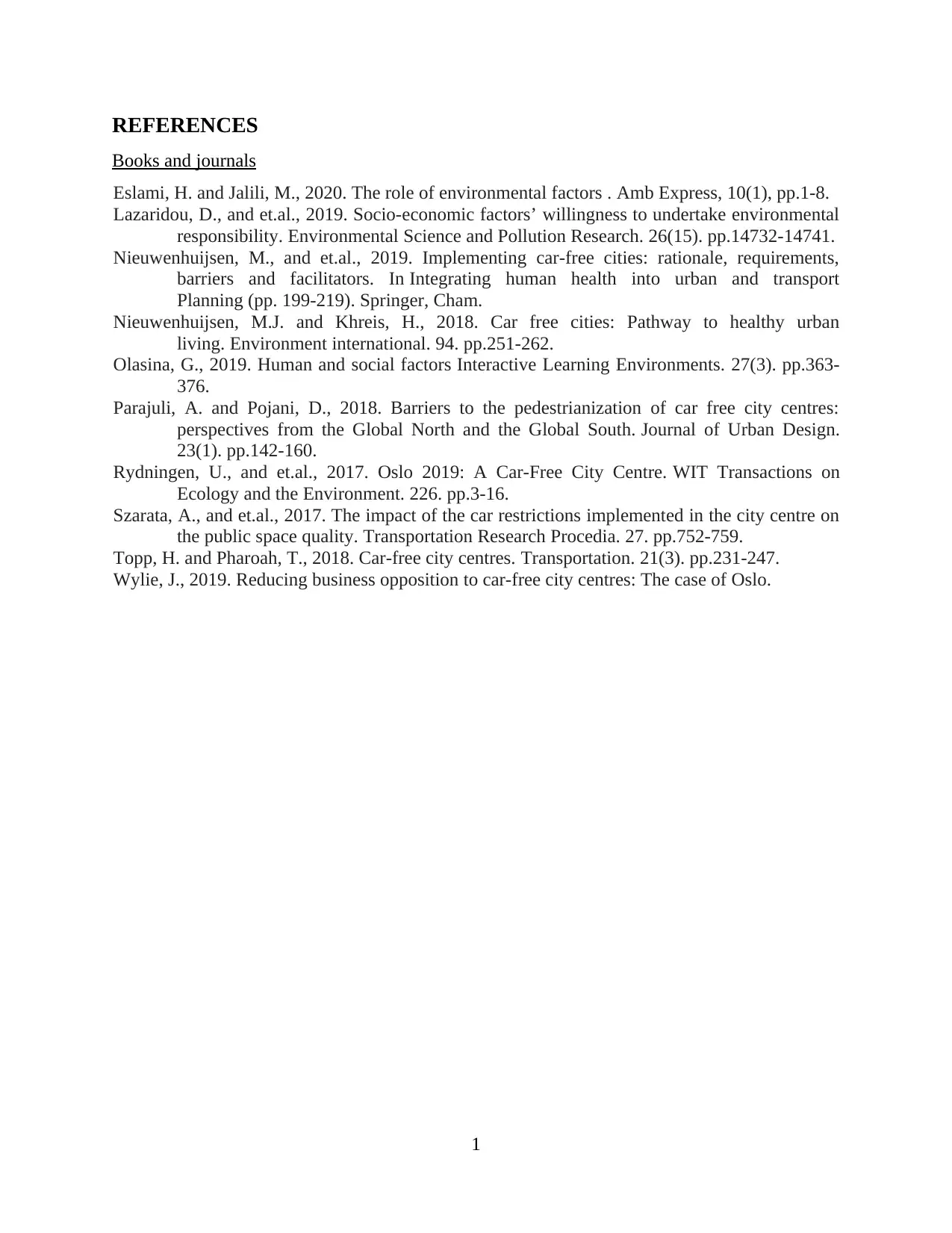
REFERENCES
Books and journals
Eslami, H. and Jalili, M., 2020. The role of environmental factors . Amb Express, 10(1), pp.1-8.
Lazaridou, D., and et.al., 2019. Socio-economic factors’ willingness to undertake environmental
responsibility. Environmental Science and Pollution Research. 26(15). pp.14732-14741.
Nieuwenhuijsen, M., and et.al., 2019. Implementing car-free cities: rationale, requirements,
barriers and facilitators. In Integrating human health into urban and transport
Planning (pp. 199-219). Springer, Cham.
Nieuwenhuijsen, M.J. and Khreis, H., 2018. Car free cities: Pathway to healthy urban
living. Environment international. 94. pp.251-262.
Olasina, G., 2019. Human and social factors Interactive Learning Environments. 27(3). pp.363-
376.
Parajuli, A. and Pojani, D., 2018. Barriers to the pedestrianization of car free city centres:
perspectives from the Global North and the Global South. Journal of Urban Design.
23(1). pp.142-160.
Rydningen, U., and et.al., 2017. Oslo 2019: A Car-Free City Centre. WIT Transactions on
Ecology and the Environment. 226. pp.3-16.
Szarata, A., and et.al., 2017. The impact of the car restrictions implemented in the city centre on
the public space quality. Transportation Research Procedia. 27. pp.752-759.
Topp, H. and Pharoah, T., 2018. Car-free city centres. Transportation. 21(3). pp.231-247.
Wylie, J., 2019. Reducing business opposition to car-free city centres: The case of Oslo.
1
Books and journals
Eslami, H. and Jalili, M., 2020. The role of environmental factors . Amb Express, 10(1), pp.1-8.
Lazaridou, D., and et.al., 2019. Socio-economic factors’ willingness to undertake environmental
responsibility. Environmental Science and Pollution Research. 26(15). pp.14732-14741.
Nieuwenhuijsen, M., and et.al., 2019. Implementing car-free cities: rationale, requirements,
barriers and facilitators. In Integrating human health into urban and transport
Planning (pp. 199-219). Springer, Cham.
Nieuwenhuijsen, M.J. and Khreis, H., 2018. Car free cities: Pathway to healthy urban
living. Environment international. 94. pp.251-262.
Olasina, G., 2019. Human and social factors Interactive Learning Environments. 27(3). pp.363-
376.
Parajuli, A. and Pojani, D., 2018. Barriers to the pedestrianization of car free city centres:
perspectives from the Global North and the Global South. Journal of Urban Design.
23(1). pp.142-160.
Rydningen, U., and et.al., 2017. Oslo 2019: A Car-Free City Centre. WIT Transactions on
Ecology and the Environment. 226. pp.3-16.
Szarata, A., and et.al., 2017. The impact of the car restrictions implemented in the city centre on
the public space quality. Transportation Research Procedia. 27. pp.752-759.
Topp, H. and Pharoah, T., 2018. Car-free city centres. Transportation. 21(3). pp.231-247.
Wylie, J., 2019. Reducing business opposition to car-free city centres: The case of Oslo.
1
1 out of 10
Related Documents
Your All-in-One AI-Powered Toolkit for Academic Success.
+13062052269
info@desklib.com
Available 24*7 on WhatsApp / Email
![[object Object]](/_next/static/media/star-bottom.7253800d.svg)
Unlock your academic potential
Copyright © 2020–2025 A2Z Services. All Rights Reserved. Developed and managed by ZUCOL.



